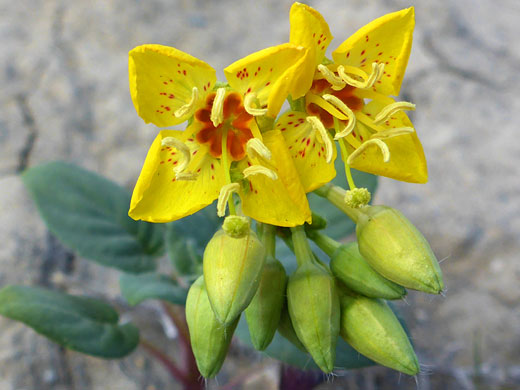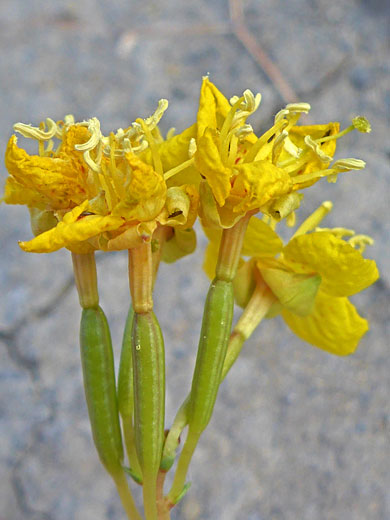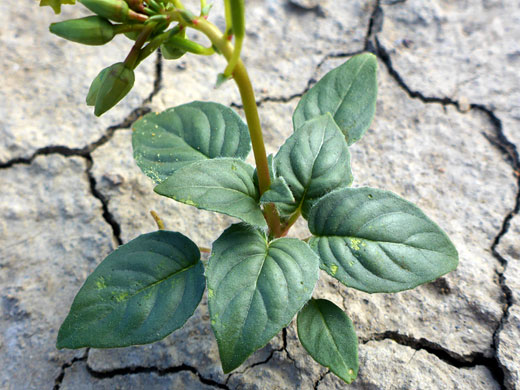Common name:
Paiute suncup
Family:
Scientific name:
Chylismia scapoidea
Main flower color:
Range:
Scattered areas across much of the west, most common in south Idaho and southeast Oregon, and from northern New Mexico to Wyoming
Height:
Up to 18 inches
Habitat:
Open flats, on sand or clay, from 2,300 to 7,000 feet
Leaves:
Up to 6 inches long, on stalks of up to 2 inches; small lateral lobes (often absent) and a large, ovate terminal lobe
Season:
March to May
Chylismia scapoidea is quite a distinctive species, as the yellow petals are flecked with red dots, and they may have a larger red patch at the base, giving the whole flower a red center. Petals become orange as they wither. There are eight stamens - yellow filaments and lighter yellow anthers - and a style with a spherical stigma, approximately the same height as the stamens, though these are of two lengths; those attached at the base of the petals are a little shorter than those attached between. Sepals are greenish-yellow, similar in width to the petals, though shorter. The ovarian tubs is green, hairless and somewhat shiny.
Stems and leaves are sparsely hairy, sometimes glandular. Stems are usually unbranched. Leaves are mainly basal, but there may be an opposite pair of much smaller stem leaves. Leaves may be lobed, but more often, only the large terminal lobe is present, this ovate to elliptic, up to 2 inches long. Leaf margins are usually shallowly toothed. The undersurfaces of the leaves are dotted with oil glands, often inconspicuous.
There are four subspecies of chylismia scapoidea; the widespread ssp scapoidea has unlobed leaves and smaller fruits, while ssp macrocarpa of northern Arizona, also has unlobed leaves, and larger fruits. Ssp brachycarpa has a few lateral leaf lobes, and smaller fruits. Ssp brachycarpa has well developed lateral leaf lobes, and larger fruits.
Stems and leaves are sparsely hairy, sometimes glandular. Stems are usually unbranched. Leaves are mainly basal, but there may be an opposite pair of much smaller stem leaves. Leaves may be lobed, but more often, only the large terminal lobe is present, this ovate to elliptic, up to 2 inches long. Leaf margins are usually shallowly toothed. The undersurfaces of the leaves are dotted with oil glands, often inconspicuous.
There are four subspecies of chylismia scapoidea; the widespread ssp scapoidea has unlobed leaves and smaller fruits, while ssp macrocarpa of northern Arizona, also has unlobed leaves, and larger fruits. Ssp brachycarpa has a few lateral leaf lobes, and smaller fruits. Ssp brachycarpa has well developed lateral leaf lobes, and larger fruits.
All Contents © Copyright The American Southwest | Comments and Questions | Contribute | Site Map




